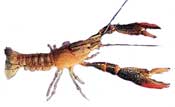

Cherax quadricarinatus
Red claw crayfish (Australian crayfish, Cherax quadricarinatus) should be very similar in culture methods and economic data to the freshwater shrimp (Macrobrachium rosenbergii). However, there are several differences. One difference between the two species is that red claw will, at the present time, cost more for stocking-size individuals, due to the location (Belize) of the hatchery. Persons in the U.S. who sell red claw generally produce small numbers of individuals (2200-1,000) and these are not sufficient numbers to stock even a small pond. Another difference is that red claw can spawn in freshwater, not seawater as the freshwater shrimp requires. Thirdly, red claw do not undergo larval stages like freshwater shrimp and can ear a pelleted diet after being released from the female. These last two characteristics of red claw make them easier for a producer to establish his/her own hatchery. A drawback to red claw juvenile production is their much lower fecundity rate compared to the freshwater shrimp. Red claw females generally produce from 100 to 1000 juveniles per female; however, survival is high because they do not have larval stages. A fifth difference between the two species is that red claw can be sold to the aquarium industry where they are highly desired because of their colorful shell. Aquarium industry can pay a supplier up to $2 per inch for a small (1-3 inches) red claw to be sold as an aquatic pet. A sixth difference is that red claw can tolerate somewhat cooler water temperatures than the freshwater shrimp so that the growing season could be increased. However, like the freshwater shrimp, red claw die when water temperatures decline to 50oF; therefore, they should not pose a threat to native crayfish species in Kentucky, nor do they burrow. Lastly, red claw can be grown in tanks somewhat more easily than the freshwater shrimp due to its less cannibalistic nature if shelters are provided. Red claw offer another alternative for Kentucky producers who desire to grow them and/or start a hatchery operation. |